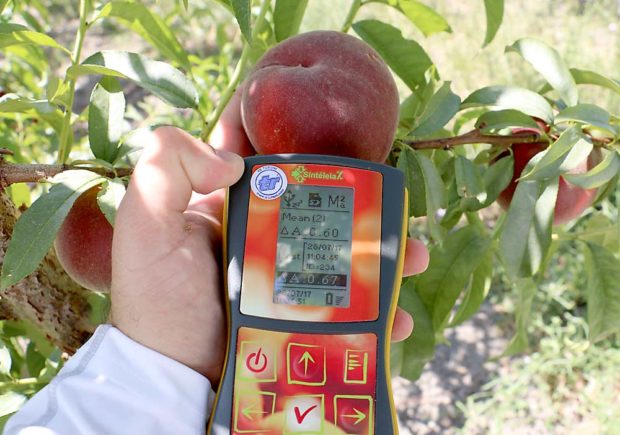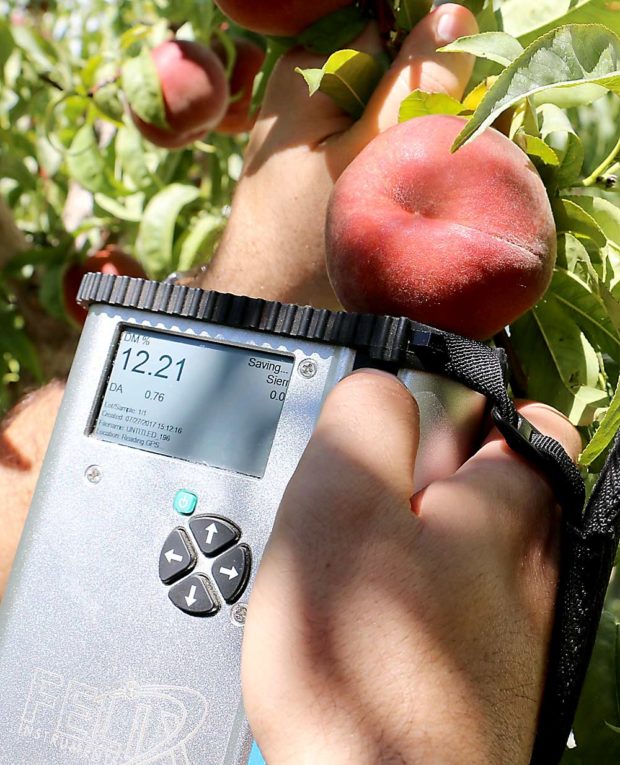
A juicy, tasty, fresh peach captures the essence of summer, and does it in a vibrant, fuzzy package. Unfortunately, U.S. consumers don’t always get that experience from their fruit. Instead, they sometimes bite into dry, mushy, mealy, discolored peaches, and it’s taking a toll on sales, said Ioannis Minas, assistant professor of pomology at Colorado State University.
In a talk at the Great Lakes Fruit, Vegetable and Farm Market Expo in December, Minas pointed to U.S. Department of Agriculture statistics showing that consumption of fresh peaches declined by more than half in the past 25 years, dropping from nearly 7 pounds in 1980 to less than 3 in 2015. Minas and his colleagues hope to counter that trend by honing in on the characteristics of a great peach and using newer, nondestructive tools to identify the preharvest practices that foster those qualities.
Nondestructive measures
Maturity is a big factor in peach consumer quality. It determines when it should be harvested, how it is packed and transported, and whether it satisfies the ultimate consumer. Measures of ripeness and quality include firmness, soluble solids concentration (or the Brix index), dry matter content (or all of the nonwater parts of a fruit), and background color.
Over the past three years, Minas and his group tested two nondestructive devices on hundreds of Sierra Rich, Cresthaven and Red Haven fruits in the peach-growing region of Colorado and compared readings from the devices to measurements obtained through the traditional destructive methods.
One device is the F-750 Produce Quality Meter, which shines near-infrared light on fruit and measures how the light interacts with molecules in the flesh to reveal peach firmness, soluble solids and dry matter content. The other is the DA meter, which also uses light, but to measure chlorophyll content just below the skin of the fruit and read the background color.
“The DA meter is really helpful on the varieties of peaches with full red color, where the pickers or the crew leader have a hard time justifying when to pick, compared to the traditional bi-color varieties where you can see the background color,” Minas said.
The study enabled the researchers to develop prediction models that equate device readings to fruit quality for the varieties grown in the region. He said the models have proven so reliable in predicting quality measures that “we trust the models more” than the destructive methods.
Minas’ research is funded by the Colorado Agricultural Experiment Station, Western Colorado Horticultural Society and Colorado Department of Agriculture Specialty Block Grant Program.

Growing better peaches
The researchers have put the devices to work in a number of studies over the past three years. One analyzed the effect of thinning on peach quality. They looked at 1,200 fruits: 300 each from unthinned, lightly thinned (one fruit every 2 inches), commercially thinned (one fruit every 6 inches) and heavily thinned trees (one fruit every 12 inches).
“As we thinned more, we saw predicted values shift toward higher dry matter and higher improved quality,” Minas said. “We saw the same thing with soluble solids, so as we thinned more, we got more sugars available for the fruit, which makes sense.”
For instance, dry matter on average increased from 10.9 percent in unthinned trees to 14 percent with commercial thinning; soluble solids on average increased from 10.1 percent in unthinned to 13.3 percent with commercial thinning.
“Overthinning mainly increased the amount of fruit classified in higher dry matter and soluble solids levels, but the average values were slightly increased compared to commercial thinning,” he said. “These findings indicate that crop load management is the major factor affecting peach quality, and that the sacrifice in yield above a threshold is not adding extra benefits in terms of quality.”
The DA meter measurements of chlorophyll content also showed that ripening time accelerates with increased thinning. Unthinned trees ripened five to seven days later than commercially thinned trees, which in turn ripened one day later than the heavily thinned ones.
Minas’ group also investigated how canopy position affects peach quality. With Sierra Rich and Cresthaven, they used the DA meter to select fruit with the same background color and therefore at the same maturation stage, and then employed the F-750 Produce Quality Meter to compare dry matter content.
The variation in dry matter they found occurred when dense canopy growth prevented sufficient light penetration in the lower canopy. Specifically, the average dry matter content per fruit was 11.6 percent in the lower third of the trees, slightly higher at 11.8 in the center third of the trees, and much higher at 13.2 in the top third in dense canopies. In trees with optimum light penetration through the canopy, it remained the same regardless of the fruit position.
Then, they turned the devices toward rootstock effects, comparing Atlas, Bright’s Hybrid 5, Guardian, Krymsk 86, Lovell, Controller 5 and Krymsk 1.
“The larger the tree, the lower dry matter you get, so there’s a trend that the quality goes the opposite way from the tree size,” Minas said. “These results on rootstocks, combined with the findings from the canopy position trials, further highlight the importance of tree vigor control and light penetration for optimum fruit quality.”
On Red Haven, for instance, the vigorous Atlas and Bright’s Hybrid 5 rootstocks had dry matter content of about 13.6 to 13.7 percent, while the dwarfing Controller 5 and Krymsk 1 rootstocks had dry matter contents of about 14.7 to 14.8 percent.
“The overall objective of this work is to better understand how fruit quality is built in an orchard system focusing on the effect of crop load, canopy position, rootstocks and training systems,” Minas said.
More to learn
Now that Minas feels confident in using these new nondestructive devices to measure peach quality, he plans to continue refining the path to a better peach. That includes additional work on how growers may be able to use the tools in the field. He is especially interested in putting DA meters in the hands of orchard workers so they have a tool that doesn’t destroy fruit or rely on subjective measures.
“The DA meter does not correlate with fruit firmness, but we have data to show that it correlates better with fruit physiological maturity (than firmness),” Minas said. “However, it needs a lot of study in order to adopt it at the industry level.”
While his research group has found the prediction models work very well in terms of estimating peach fruit quality during development, it’s unclear if growers can adopt them readily at this stage.
“Right now, we are using them as research tools to understand better preharvest factors and to be able to give recommendations about what kinds of treatments, such as pruning, rootstocks, etc., promote fruit internal quality,” he said. “My hope is that with technological development, we will have even smaller devices so growers can test internal quality and fruit maturity in the field.” •
—by Leslie Mertz






Leave A Comment